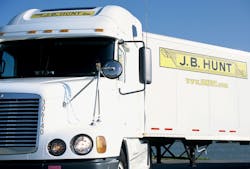The initial third quarter earnings reports from several large carriers serving varied niches within the trucking industry indicate that rising “headwinds,” especially in the form of higher diesel prices and slowing freight volumes, are putting greater strain on their bottom lines.
Airport-to-airport freight hauler Forward Air Corp. noted that uneven volumes in particular affected profitability in the third quarter, even though revenues increased due to higher rates.
The carrier said its net income dropped to $12. 3 million on 5.7% higher operating revenue of $143.5 million in the third quarter this year, compared to net income of $12.6 million on $135.7 million in operating revenue for the same quarter in 2011.
“We have continued to experience choppiness in our daily tonnage numbers, but there were some signs of firming,” noted Bruce Campbell, Forward Air’s chairman, president, and CEO, in the carrier’s third quarter earnings report. “Our operations group will continue to monitor our volumes and freight flows and will dynamically adjust to fluctuations in network volumes to effectively control our costs.”
That being said, Campbell stressed that the carrier anticipates fourth quarter revenues should increase in the range of 5% to 8% over the same period in 2011 period.
Refrigerated carrier Marten Transport Ltd. Said its net income jumped 2.9% to $6.5 million on higher operating revenues from its truckload and logistics operations of $163.6 million compared to the same quarter in 2011.
Yet it added that operating expenses as a percentage of operating revenue, with both amounts net of fuel surcharge revenue, increased to 92.6% for the third quarter this year from 91.3% during the same quarter in 2011.
“Our earnings were negatively impacted by near-term headwinds – steadily rising diesel fuel prices, extreme heat and the persistently weak economy impacting volumes,” noted Randolph Marten, the carrier’s chairman and CEO.
“In spite of the challenging circumstances, our truckload and intermodal revenue, each net of fuel surcharges, increased 5.4% and 11.2%, respectively, over last year’s third quarter, while our brokerage revenue increased 7.9% over the same period,” he pointed out.
Yet such increases are being tempered by rising costs. “We continue to see improvement in our average truckload revenue, net of fuel surcharges, per tractor per week, which increased 7.3% in the third quarter over the same quarter last year, but the improvement was offset by increased costs in driver wages and net fuel expense,” Marten noted.
The impact of rising costs on Marten’s bottom line didn’t surprise John Larkin, a transportation analyst with Stifel Nicolas, who noted in a research brief that he expects to see higher driver wages persist moving forward as the continued tight driver market currently being experienced in the industry will continue as higher quality drivers will command a premium per-mile.
Larkin added that Marten suffered a 0.3% decrease in truckload revenue per loaded mile, excluding fuel surcharges, which represents the second quarter in a row of negative year-over-year changes in truckload revenue after a series of low double digit and high single digit year-over-year increases from mid-2010 through the first quarter of this year.
“That illustrates the softness in pricing in the trucking market related to the general slowdown in the economy,” he said.
By contrast, carriers that are diversifying away from the “traditional” long-haul truckload are seeing success from a profitability perspective.
For example, J.B. Hunt Transport Services posted third quarter net earnings of $78.2 million on total operating revenue of $1.3 billion versus net earnings of $68.7million on operating revenue of $1.17 billion during the third quarter last year primarily due load growth of 15% from its intermodal division and a 38% boost in freight hauled by its Integrated Capacity Solutions (ICS) operation – helping drive 15% and 30% increases in segment revenue, respectively.
While J.B. Hunt’s Dedicated Contract Services (DCS) segment increased operating revenue by only 1% primarily driven by the start up of new accounts occurring later than expected, the carrier noted that its traditional truckload segment took it on the chin in the third quarter, with revenue declining primarily due to operating approximately 9% fewer trucks.
Stifel Nicolas’ Larkin added that trends within J.B. Hunt illustrate that the carrier’s shift away from “traditional” truckload continues to gain steam.
“We noted that the company continues to shift the truckload segment in the direction of using more owner-operators in order to allocate less capital to [that] segment,” he said. “Company-owned tractors decreased 13% year-over-year and independent contractors only declined by 1% year-over-year.”
About the Author
Sean Kilcarr
Editor in Chief
Sean Kilcarr is a former longtime FleetOwner senior editor who wrote for the publication from 2000 to 2018. He served as editor-in-chief from 2017 to 2018.
